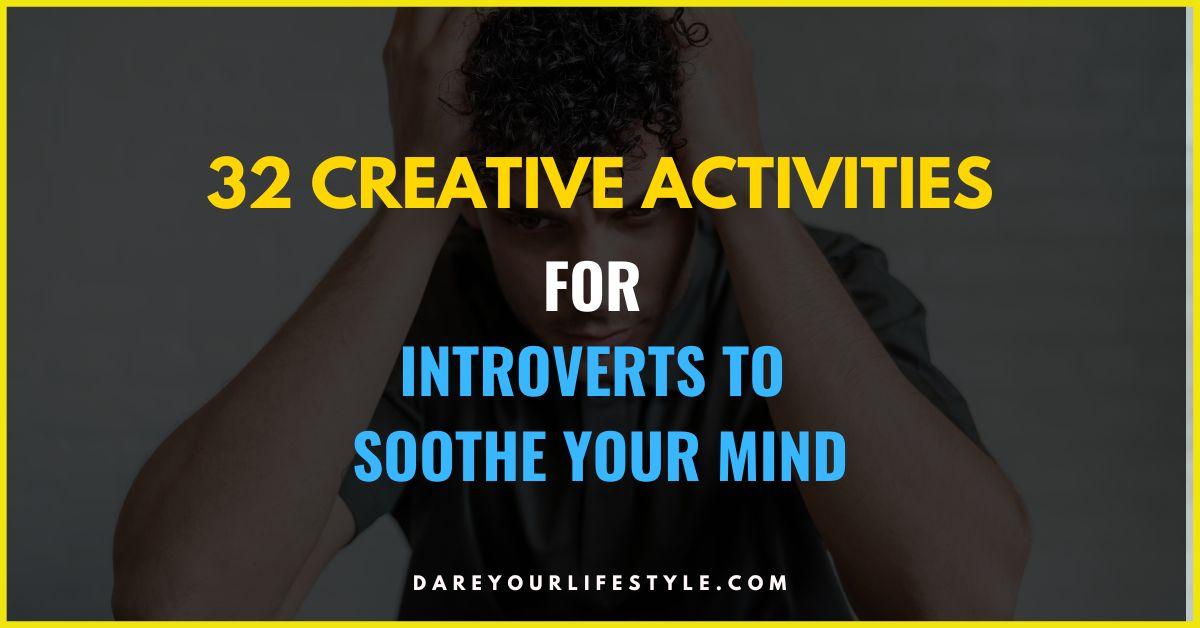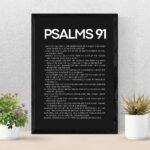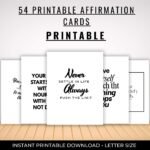Disclaimer: This post may contain affiliate links, meaning we get a small commission if you make a purchase through our link at no extra cost to you. For more information, please visit our Disclaimer Page.
Activities for introverts are essential for maintaining mental well-being and personal satisfaction.
These activities cater specifically to introverted personalities, providing a comfortable space for self-reflection and relaxation.
Engaging in activities that align with one’s personality not only feels natural but also offers significant benefits in terms of mental rejuvenation and fulfillment.

Creativity suits quiet minds. When you enjoy ideas, patterns, and rich inner worlds, expressive hobbies can feel like fresh air. They let you go deep without constant chatter, and they fit around your energy instead of draining it. The research is kind, too: creative activity reduces stress and supports emotional balance, whether it is journaling, coloring, making music, or sketching a moment you want to remember (Time reports strong links between journaling and mood benefits; WebMD describes the calming effect of coloring; music making has measurable impacts on dopamine and anxiety; The Atlantic highlights how creating art can quiet worry). Links appear throughout so you can skim what interests you most.
The ideas below are practical, budget friendly, and introvert friendly. Some are purely solo. Some invite light community. All can be scaled up or down depending on your time and focus.
Before the list, a small suggestion. Pick one activity you can start in ten minutes today. Keep tools simple. Tiny repeatable sessions add up to mastery and confidence.
How to use the list
- Look for the “free or almost free” notes. Most ideas work with things you already own.
- Choose the social level that fits your energy that day. Many options include a solo version and a small-group version.
- If you want “near me” ideas, scan the “where to find” notes and the table. Meetup, libraries, community centers, and nature organizations are gold mines.
- Mix indoor creativity with a short outdoor reset. Nature time lowers cortisol and improves mood, and even 20 minutes helps (Time).
At home and indoors: quiet projects that refuel you
- Morning pages journaling Free or almost free. Open a notebook, set a 10-minute timer, and write without editing. No audience, no expectations. This simple ritual improves self-awareness and reduces rumination, and studies tie journaling to mood and stress relief (Time). Try it: Keep the notebook on your pillow so you write before touching your phone. Choose one nightly prompt you repeat for a week, for example, “What energized me today?”
- Micro-poetry Write a haiku while your tea steeps, or seven lines on a single sensory detail. Keep a running notes file on your phone for poetic fragments that appear while commuting. Free twist: Pair a photo you took with a three-line poem and post it to a private album.
- Short-story sprints or a tiny blog Choose a micro-genre, like 300-word mysteries or two-paragraph sci-fi vignettes. A consistent constraint reduces decision fatigue. Use a free blog platform if you want a home for your pieces. Social option: Swap stories in a small online forum or attend a low-pressure writing circle at your library. Turn-taking keeps conversation structured.
- Sketchbook habit Five minutes of blind contour drawing. A page of circles that morph into objects. One still life per week using whatever is on your desk. Adult coloring and focused sketching are calming; coloring books in particular help quiet intrusive thoughts by steering attention to a simple task (WebMD). Tools: Pencil, pen, or a child’s set of colored pencils is plenty.
- Watercolor postcards Small paper, small brush, small time slot. Paint abstract washes, a slice of your morning window, or a cat silhouette. Slip finished cards into a box for future notes to friends. The point is playful color, not perfection.
- Meditation through coloring Buy a $5 coloring book or print a free mandala. Ten minutes can shift a tense afternoon into a steady evening. WebMD notes the mind settles as you color. Tip: Put a magazine file on your table with a few pages, pencils, and a sharpener. Visible tools invite action.
- Knitting or crochet sampler The rhythm is deeply soothing, and research links fiber crafts to calm, structure, and reduced stress hormones (The Arcadia Online, Medical Xpress, HGTV). Start with a sampler scarf where each section tries a different stitch. Free or low-cost: Borrow needles from a friend and buy one ball of yarn, or check a local craft swap.
- Embroidery or sashiko mending Use simple running stitches to repair a favorite pair of jeans or decorate a tote bag. Keep thread and needles in a zip pouch by the couch. The tactile focus eases an over-busy mind.
- Collage and art journaling Cut color, texture, and words from old magazines. Glue them into a notebook, then respond with a sentence or two. This combines visual play with reflective writing.
- Origami and paper engineering Start with cranes, boxes, and jumping frogs. Paper folding gives instant feedback and can be meditative. Create a small shelf of finished forms. Free: Use scrap paper or old calendar pages.
- Calligraphy and hand lettering Practice alphabets for 10 minutes with a felt-tip brush pen. Letter a quote you like and pin it above your desk. Skill comes from consistent lines, not fancy gear.
- DIY candle, soap, or natural dyes Low-heat stove projects scratch the craft itch. For dyes, try onion skins, avocado pits, or black tea on scraps of cotton. Simple materials make it approachable and safe.
Digital creativity on a budget
13) Digital illustration with free tools GIMP, Krita, Canva, and Procreate Pocket (low-cost) cover everything from loose concept art to polished icons. Pick one brush, one palette, and one subject for the week to avoid choice overload.
- Home still-life photography and editing Stage a coffee mug, a plant, and a window. Shoot with your phone, then edit in Snapseed or Lightroom Mobile. Explore one control today, for example, contrast only. Photography invites mindful seeing and works well for solo focus.
- Micro-videos and simple editing Use iMovie, CapCut, or DaVinci Resolve to cut 15 to 45-second clips. Edit a recipe, a sketch timelapse, a day-in-objects. Keep the cadence small so it stays fun.
- Music production or songwriting GarageBand or BandLab can build a track in an evening. Lay a four-chord progression and hum a melody. Music creation is linked to boosts in dopamine, reductions in anxiety, and better emotional resilience (MusicRadar). No instrument? Try virtual instruments or sample packs.
- Voice journaling or a private podcast Record a memo each day where you read a poem you wrote, outline a story idea, or talk through your day. Keep it offline or share with one trusted friend. Pair with a weekly transcript to bring in writing practice.
- Creative coding Draw shapes and animations with p5.js, make a tiny game with Godot or Scratch, or code a generative poster. Coding can be a reflective creative outlet with a clear feedback loop and lots of solo learning resources. Free resource: The p5.js web editor runs in a browser, nothing to install.
- 3D modeling with Blender Model a simple mug, a house, or a logo. Watching a single short tutorial and then duplicating it builds momentum. Render a still image as your “win” for the day.
- Zine design and desktop publishing Make an 8-page zine on a single sheet of paper or a digital PDF. Topic ideas: your reading life, birds you saw this month, favorite recipes. Post to a free file host or print at home and leave copies at a coffee shop with permission.
Outdoor reset and nature-inspired art
21) Nature journaling Carry a pocket notebook on a walk. Note three sounds, two textures, and one color. Add a quick sketch. Nature time restores attention and lowers stress markers, and even short forest walks help (Time). Supplies: Any notebook, a pencil, portable curiosity.
- Birdwatching with a notebook Observe from your window or a park bench. Record time, weather, behavior, and silhouette. A North Carolina State study found birdwatching improved well-being and reduced distress more than generic nature exposure for students (NC State News). Optional: A free bird ID app and basic binoculars, though you can start with the naked eye.
- Gardening or container herbs A few pots of basil and thyme count. Tending plants is tactile, structured, and peaceful. Studies link gardening to improved mood and lower cortisol (PMC). Space saver: A sunny windowsill and a repurposed tin can.
- Urban sketching Sit for 15 minutes and draw the corner bakery, a bus stop, or a fire escape. Choose one building detail per outing. The repetition builds line confidence and invisible social connection to your neighborhood.
- Plein air painting mini sessions Keep a tiny watercolor kit in your bag. Paint color blocks of the sky at different times of day. You do not need a dramatic landscape. A parking lot shadow is enough.
- Soundwalks and field recording Take a slow walk and listen for layers: near sounds, mid-range sounds, distant sounds. Record a minute on your phone. Label and archive. This tunes attention and makes you present.
Social activities that feel comfortable and help you meet people
27) Silent Book Club People gather, chat briefly, then read in silence together before optional conversation. The format is explicitly introvert friendly and now exists in many cities. NPR covered how the structure works and why it is so appealing. Search Silent Book Club in your city or on Meetup or Facebook. Pro tip: Bring a book you already enjoy so the social piece stays light.
- Writing workshop or critique circle Libraries and bookstores often host free or low-cost groups. Turn-taking and a shared focus on text keep interaction purposeful. If you prefer online, try Wattpad or a focused subreddit for asynchronous feedback.
- Craft circle or knit night Local yarn shops, fabric stores, and craft studios run open tables where people bring a project and work side by side. Conversation rises naturally around yarn colors or stitches. Craft work releases endorphins and drops stress hormones, which helps everyone relax (HGTV).
- Photography walk with a small group Community colleges, camera clubs, and Meetup organizers host photo walks with 5 to 12 people. The task comes first, chatter second. Research on structured creative classes shows that activity-based social time can feel comfortable and paced for quiet participants (OurMental.Health).
- Community garden volunteer hours Working plots offers teamwork without forced small talk. Planting and harvesting create comfortable conversation anchors. Community gardening is linked with lower stress and improved self-esteem (PMC). Find it: Your city’s parks department, a local nonprofit, or a neighborhood association.
- Cooking or baking workshop for adults Short classes are focused and clear. You follow a recipe, share tasks, and then enjoy food. Organizers often cap classes around a dozen people. This format reduces pressure to make small talk since the process guides everyone (OurMental.Health). Budget approach: Join a library demo or a community center class rather than a premium culinary school.
Free and low-cost toolkit
- Writing: Any notebook or a plain text app. Optional free prompts online.
- Art: Copy paper, a pencil, a cheap watercolor set, or a $2 brush pen.
- Music: Free DAWs like BandLab or GarageBand, a phone as recorder.
- Digital: GIMP, Krita, Canva, DaVinci Resolve, Blender, p5.js web editor.
- Nature: A notebook, a pen, and a pair of comfortable shoes.
- Social: Library calendars, Meetup, Eventbrite, Facebook groups, community college continuing education pages.
Micro-structures that make habits stick
Use a simple routine to keep the creative door open:
- Time boxing. Choose a block, for example, 12 minutes. Stop when the timer rings.
- The visible tray. Put tonight’s tools on a tray you can grab without thinking.
- One constraint. One palette, one brush, one subject. Constraints free the mind.
- Track streaks. Mark a calendar square for every day you show up for at least five minutes.
- Energy matching. Pair solo activities with low-energy days and small-group activities with days after you have had rest.
Finding events near you without the noise
- Search smart on Meetup and Eventbrite. Use keywords like introvert, quiet, book, knitting, photo walk, nature, plein air. Read comments for clues about group size and format.
- Scan library and community center calendars. These are full of structured, low-cost workshops and clubs, many designed for adults after work hours.
- Check local nature centers and park districts. Guided bird walks, plant ID hikes, and morning yoga on the lawn tend to be focused and gentle.
- Ask hobby shops. Yarn stores, camera shops, and art supply stores often know the quiet gatherings and can point you to small circles that match your vibe.
- Start online, ease into offline. Join a creative forum for a month, then attend a single meetup they recommend. Familiar names make the first hello easier.
Supportive research at a glance
- Writing and journaling can improve mindfulness and self-compassion, while easing stress (Time).
- Coloring and similar focused art can quiet intrusive thoughts and help the brain rest (WebMD).
- Creating music is tied to measurable increases in dopamine and reduced anxiety (MusicRadar). Even listening can lower stress hormones (Time).
- Crafting activities release endorphins, and knitting brings calm and structure (HGTV, Medical Xpress, The Arcadia Online).
- Time outdoors, especially in green spaces, lowers cortisol and improves mood (Time). Birdwatching showed distinct mental health benefits in a university study (NC State News).
- Structured creative workshops often provide relaxed, paced social interaction that suits quiet temperaments (OurMental.Health).
Ideas to combine activities for a fuller week
- The one-hour rotation. Fifteen minutes each of journaling, coloring, digital illustration, and a short walk with a note. Variety without overwhelm.
- The story-and-sound pairing. Record a soundwalk, then write a 200-word scene inspired by the audio. Create a minimalist cover in Canva and share it with a friend.
- Craft and community. Knit at home all month, then attend one yarn shop circle to ask questions and meet a mentor. Take a picture of your progress for your journal.
- Garden-to-zine. Grow a pot of basil, sketch it weekly, and compile a monthly zine with notes, sketches, and recipes.
- Book, cook, and look. Read during Silent Book Club, try a recipe from the book at home, then photograph the finished dish for a micro-blog post.
If you want creative friends while staying true to your pace
- Start with parallel play. Choose events where people work side by side: Silent Book Clubs, knit nights, photo walks, open studio hours. Conversation happens naturally.
- Pick a role. Bring the hole punch, carry extra pencils, be the person who shares a simple checklist. A useful role dissolves small-talk pressure.
- Set a time window. Tell yourself you are staying for 45 minutes. If you feel good, stay longer. If you are ready to head out, you kept your promise to yourself.
- Use the one-question rule. Prepare one question tied to the activity, for example, “What lens are you using for this light?” Then pause and listen.
Small wins to celebrate
- Your first five-day streak of any creative habit.
- Finishing a single watercolor postcard you like.
- Showing up to a workshop even if you did not speak much.
- Printing your first zine, even if it is one copy.
- Planting seeds and seeing the first true leaves.
- A photo you edited that makes you feel calm when you look at it.
Troubleshooting common blockers
- “I do not have time.” Try five-minute sessions. Put tools in reach. Attach the habit to something you already do, like after brushing your teeth.
- “I am not good at this.” Treat 20 early pieces as warmups. Quantity builds quality. Keep a “first 20” folder and label it proudly.
- “Materials are expensive.” Use what you have. Borrow from friends. Visit the library’s makerspace. Choose free apps.
- “Social events exhaust me.” Choose small, structured groups. Arrive early to settle in. Leave on schedule. Plan quiet time later that day.
- “I lose momentum.” Track streaks, revisit an earlier prompt, or switch to a parallel activity from the same family, for example, from sketching to collage.
A gentle weekly plan you can copy
- Monday: Morning pages for 10 minutes, color one page at night.
- Tuesday: 20-minute p5.js sketch or Canva poster.
- Wednesday: Nature journaling walk, two sketches and a color note.
- Thursday: Knit 20 rows or practice calligraphy strokes for 15 minutes.
- Friday: Edit a photo set and post one image privately.
- Saturday: Join a Silent Book Club or a small photo walk, then rest.
- Sunday: Cook or bake something, record your voice journal reflection.
Where to find your next creative moment
- Libraries for writing circles, craft hours, author nights, and quiet reading meetups.
- Community colleges for short adult courses in pottery, photography, or digital tools.
- Parks departments and nature centers for guided walks and outdoor classes.
- Meetup and Eventbrite for photo walks, knit nights, and introvert-friendly gatherings.
- Hobby shops for small circles and bulletin boards full of leads.
- Audubon chapters for beginner birding outings.
- Maker spaces for gentle project nights with tools you can try before you buy.
Creativity can be quiet, repeatable, and tailored to your energy. The 32 ideas above are only starting places. Pick one that feels light, set a tiny timer, and let your inner world take the lead.





